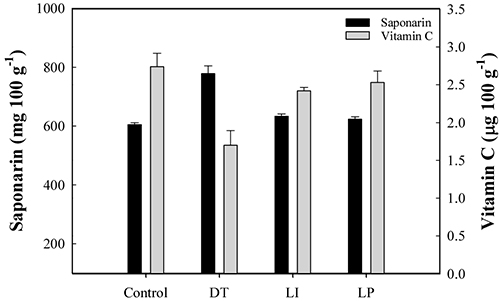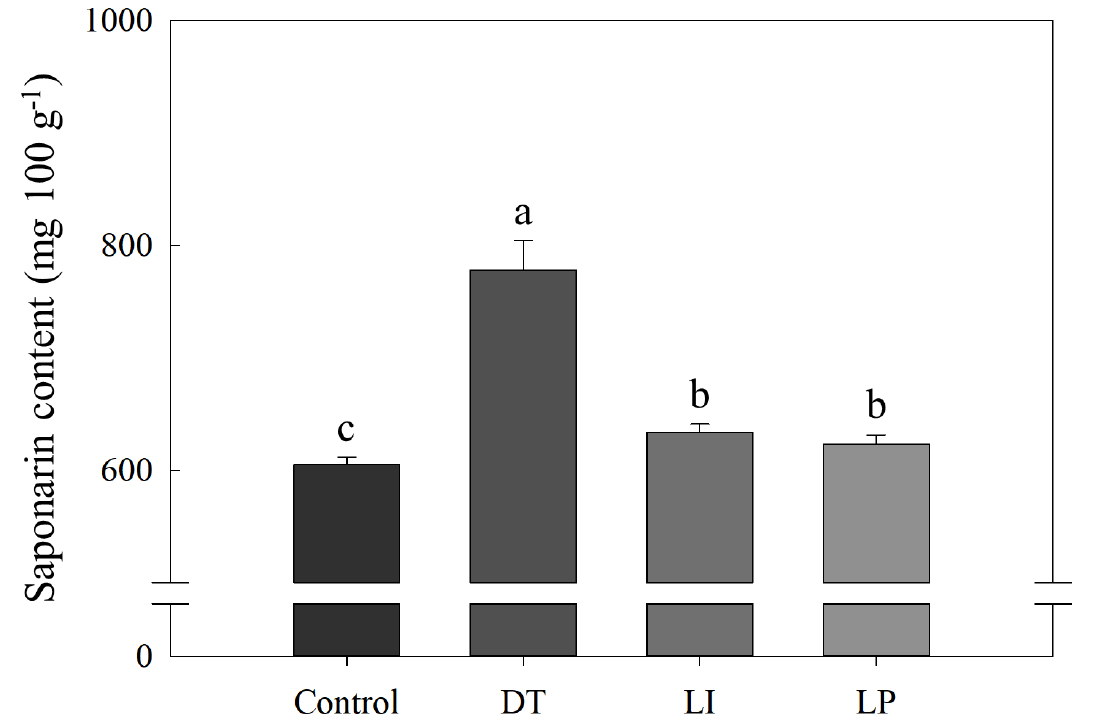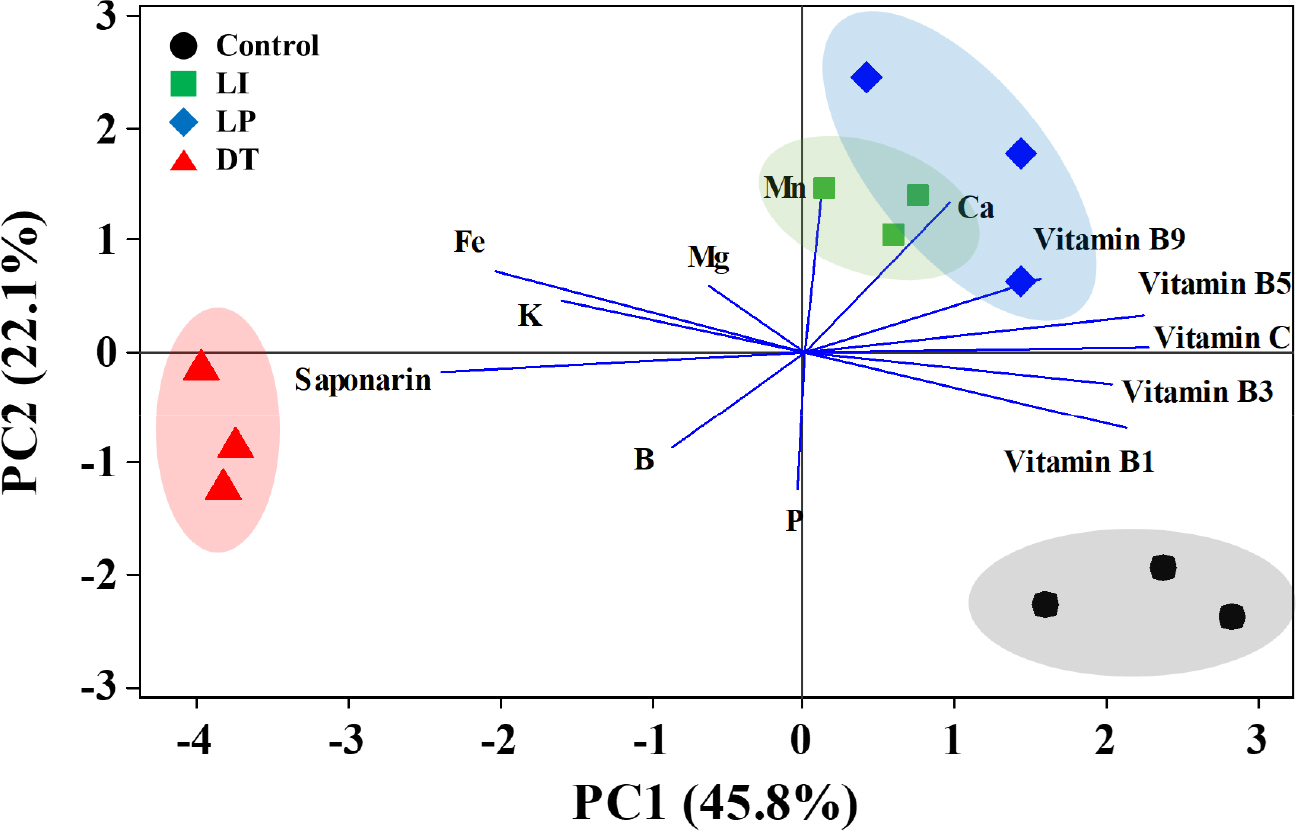Introduction
Materials and Methods
작물재배 및 수확
식물체 분석
통계분석
Results and Discussion
새싹보리 생체중 및 생육기간
새싹보리 saponarin 함량
무기성분 및 수용성 비타민 함량
주성분 분석 결과
Conclusions
Introduction
보리는 전세계적으로 재배되고 있는 주요 식량작물 중 하나로, 다양한 지리적, 기후적 환경조건에서 재배가 가능하다 (Harlan and Zohary, 1966; Lister et al., 2018). 한국에서 보리는 겨울철 월동작물로써 재배해 왔으나, 1980년도 이후 맥류 재배면적은 점점 감소하고 있었다 (KOSIS, 2019). 그러나 보리가 beta-glucan, polyphenol 등의 이차대사산물을 많이 함유하고 있다는 연구결과와 건강에 대한 사람들의 관심이 높아지면서 약용식물로써 보리 재배면적과 생산량이 증가하였다 (Izydorczyk et al., 2000; KOSTAT, 2020). 최근에는 새싹보리에 antioxidant, antidiabetic, hypolipidemic 효과가 있는 이차대사산물이 다량 포함되어 있는 것이 밝혀지면서 새로운 고부가가치 작물로 주목받고 있다 (Duh et al., 2001; Kamiyama and Shibamoto, 2012).
새싹보리는 보리가 발아하고 15 - 20 cm 자란 어린잎을 말한다. 또한, 새싹보리는 polyphenols, policosanol, glucosamine, GABA, saponarin 등의 이차대사산물을 다량 함유하고 있으며 이들의 생리활성에 대한 연구는 활발히 이루어지고 있다 (Meng et al., 2015; Kowalczewski et al., 2020; Song et al., 2020). 이와 같은 식물체내 이차대사산물은 식물의 생육환경 변화에 스스로를 방어하기 위해 합성이 되기 때문에 온도, 광, 수분 등의 외부 환경조건 조절에 의한 이차대사산물 함량 변화에 대한 연구가 활발히 진행되고 있다 (Nezval et al., 2017; Chun et al., 2019; Chung et al., 2019; Yoon et al., 2019; Jiang et al., 2020; Lee et al., 2020). 또한, 품종과 발아기간에 따른 새싹보리 내 이차대사산물 함량 차이에 관한 연구결과도 보고되고 있다 (Lee et al., 2017).
특히 saponarin은 새싹보리의 이차대사산물 중 polyphenol 계열 화합물의 약 72%를 차지하고 있으며, antioxidant, anti-inflammatory, anti-hyperglycemic, anti-obesity 등의 효과가 있는 것으로 보고되었다 (Eun et al., 2016; Ramakrishna et al., 2017; Kim et al., 2021). Saponarin 고함유 새싹보리 생산을 위한 연구는 현재 농촌진흥청 (RDA)을 중심으로 활발히 진행되고 있으며, Yoon et al. (2022)은 노지재배 새싹보리의 saponarin 함량과 외부 환경요인 (광, 온도, 수분 등)과의 상관관계에 대해 보고한 바 있다. 그러나 실내 생육환경에서 광, 온도 수분 등의 환경변화가 새싹보리 내 saponarin 함량 변화에 미치는 영향에 관한 연구는 여전히 미흡한 실정이다. 따라서 본 연구는 새로운 고부가가치 작물로 주목받고 있는 새싹보리를 대상으로 온도 및 광 변화가 기능성물질인 saponarin 함량에 미치는 영향을 분석하여 제어된 환경조건에서 saponarin 고함유 새싹보리 재배를 위한 방법확립에 대한 기초자료로 활용하고자 수행하였다.
Materials and Methods
작물재배 및 수확
본 연구에는 ‘큰알보리 1호’ 보리종자를 농촌진흥청 (RDA)에서 분양받아 사용하였다. 파종 전 모든 종자는 암실에서 하루동안 침지시켜 발아한 후 사용하였다. 파종량은 표준파종량 (840 kg 10a-1)을 기준으로 수도용 상토를 채운 모판 (30 × 60 cm)에 150 g을 파종하였다. 본 연구에서는 온도 20°C, 광량 120 µmol m-2 s-1, 광주기 12H/12H (day/night), 상대습도 65%로 설정한 식물생장기 (JSPC-960C, JS Research Inc., Korea)에서 재배한 새싹보리를 대조구로 설정하였으며, DT 처리구는 일교차를 0 → 10°C, LI 처리구는 광량을 120 → 180 µmol m-2 s-1, LP 처리구는 광주기를 12시간 → 18시간으로 조절하였다 (Table 1). 총 3반복으로 파종하여 진행하였으며, 하루에 한번 300 mL의 증류수를 급수하여 재배하였다. 새싹보리 잎의 길이가 15 cm가 되었을 때 지상부를 수확하였으며, 수확한 샘플은 진공동결건조기 (HyperCOOL, HC3110, Hanil Scientific Inc., Korea)를 사용하여 -50°C에서 2일간 동결건조 후 분쇄하여 -20°C에서 보관하였다.
Table 1.
Growth chamber conditions.
| Treatments† | Temperature (°C) | Light period (hours) |
Photons (µmol m-2 s-1) |
RH‡ (%) | ||
| Day | Night | Day | Night | |||
| Control | 20 | 20 | 12 | 12 | 120 | 65 |
| DT | 20 | 10 | 12 | 12 | 120 | 65 |
| LI | 20 | 20 | 12 | 12 | 180 | 65 |
| LP | 20 | 20 | 18 | 6 | 120 | 65 |
식물체 분석
식물체 내 무기원소 함량은 습식분해 후 Kuppusamy et al. (2017)의 방법에 따라 분석하였다. 식물체 0.2 g과 질산 10 mL을 100 mL 삼각 플라스크에 넣고 산가수분해 시킨 후 증류수를 이용해 50 mL로 희석하였으며, 0.45 µm polytetrafluoroethylene (PTFE) syringe filter (Whatman International Ltd., UK)를 사용하여 여과하였다. 여과액은 무기원소 함량 분석을 위해 유도 결합 플라즈마 분광광도계 (ICP-OES, Optima 8600DV, PerkinElmer, USA)를 사용하여 정량 하였다.
새싹보리 내 saponarin 함량 분석은 Lee et al. (2019)의 방법을 따라 수행하였다. 새싹보리 분말 1 g을 50% 에탄올 (HPLC grade ethanol, Fisher Scientific, USA) 20 mL을 첨가하고 35°C에서 24시간 동안 추출하였다. 24시간 후 7,800 rpm에서 10분간 원심분리하였고, 상등액을 0.2 µm PTFE syringe filter (Whatman International Ltd., UK)를 통해 여과하였다. 추출액의 saponarin 함량은 고성능 액체 크로마토그래피 (UHPLC, Dionex Ultimate 3000, Thermo Scientific, USA)를 사용하여 측정하였으며, 상세한 분석조건은 Table 2에 나타내었다.
수용성 비타민 함량은 Santos et al. (2012)이 보고한 방법으로 분석하였다. 새싹보리 분말 0.1 g에 혼합추출용액 (10 mM ammonium acetate 1.4 mL + methanol 1.3 mL + 50 ng ml-1 hippuric acid 100 µl)을 첨가하여고 5분간 초음파 처리 (Power Sonic 410, Power-Sonic Corp., USA)를 하여 추출하였다. 추출액은 15,000 rpm에서 5분간 원심분리하고, 상등액을 0.45 µm PTFE syringe filter (Whatman International Ltd., UK)를 통해 여과하였다. 새싹보리의 수용성 비타민 함량은 diode array detector (DAD) (Thermo Scientific, USA) 검출기가 장착된 Accela HPLC system (Thermo Scientific, USA)를 사용하였다. Column은 Atlantis dC18 column (4.6 × 100 mm, 5 mm particle size)을 사용하였고, 용매조성은 10 mM ammonium acetate (pH 4.5) (A), methanol (0.1% acetic acid) (B), methanol (0.3% acetic acid) (C)로 하였다. 용매구배는 (A) 90%, (B) 10%, (C) 0%로 시작하여 4분에 (A) 50%, (B) 0%, (C) 50%, 10분에 (A) 0%, (B) 100%, (C) 0%, 20분에 (A) 90%, (B) 10%, (C) 0%로 하여 분석하였다. 용매 흐름속도는 0.2 mL min-1으로 하였고, 파장은 200 - 680 nm, Column 온도는 20°C로 고정하여 분석하였다.
Table 2.
The instrumental condition of ultra-high performance liquid chromatography (UHPLC) for saponarin analysis.
통계분석
본 연구에서 실험은 3반복으로 수행하였으며, 실험결과의 통계분석은 R (Version 4.0.4) 프로그램을 이용하여 실시하였다. 처리구간 유의성 검정은 Tukey’s honestly significantly difference (HSD) 를 이용하여 p < 0.05 수준에서 분석하였다. Saponarin, 수용성 비타민 및 무기성분간 주성분분석은 Minitab 16 프로그램을 이용하여 실시하였다.
Results and Discussion
새싹보리 생체중 및 생육기간
수확한 새싹보리의 잎의 길이는 15.1 - 15.3 cm였으며, 생체중은 최소 0.161 g, 최고 0.163 g으로 처리구간 통계적으로 유의한 차이는 보이지 않았다 (p < 0.05). 그러나 수확기준인 15 cm까지 자라는 생육일수는 대조구에서 9일, DT, LI, LP 처리구에서는 각각 11, 8, 8일로 온도와 광 조건에 따라 생육기간이 달라짐을 나타내었다. DT 처리구에서는 일교차에 의해 생육기간 중 평균온도가 20°C에서 15°C로 감소함에 따라 생육기간이 대조구에 비해 더 길어진 것으로 판단된다. 광주기와 광량을 조절한 LI 및 LP 처리구에서는 생육기간 중 평균 일조량이 5.2 µmol m-2 day-1 (control)에서 7.8 µmol m-2 day-1로 증가함에 따라 생육일수가 감소한 것으로 판단된다. Lancashire et al. (1991)의 연구결과에 따르면 작물의 생육온도, 특히 일교차는 발아 및 잎 발생 등의 생육에 영향을 미치는 것으로 나타났으며, Kim (2021)은 일조량 변화에 의한 광합성량 차이와 그에 따른 생육 차이를 보고하였다.
새싹보리 saponarin 함량
새싹보리의 saponarin 함량 분석 결과는 Fig. 1에서 보는 바와 같다. 대조구에서 saponarin 함량은 606.6 mg 100 g-1로 나타났으나, 일교차가 10°C인 DT 처리구에서는 778.0 mg 100 g-1로 대조구에 비해 증가하는 결과를 보였다 (p < 0.001). 또한 광량과 광주기를 조절한 LI, LP 처리구의 saponarin 함량은 각각 633.4, 624.1 mg 100 g-1로 대조구에 비해 증가하는 결과를 나타내었다 (p < 0.001). 일반적으로 노지에서 재배되는 새싹보리의 saponarin 함량은 평균 1,400 mg 100 g-1 수준으로 나타나지만 (Yoon et al., 2022), 시설에서 재배되는 새싹보리의 saponarin 함량은 400 - 800 mg 100 g-1 수준으로 (Oh et al., 2021) 보고되었다. Yoon (2022)의 연구결과에 따르면 노지재배와 시설재배의 saponarin 함량의 차이는 생육온도와 광량의 차이에 의한 것으로, 광량 1,200 µmol m-2 s-1, 생육온도 10 - 20°C인 노지에서 재배된 새싹보리의 saponarin 함량이 광량 120 µmol m-2 s-1, 생육온도 20°C인 시설에서 재배된 새싹보리에 비해 더 높다는 결과를 나타내었다. 본 연구에서 재배한 새싹보리의 saponarin 함량은 시설재배 새싹보리 수준으로 나타났다. 본 연구에서 광량과 광주기를 조절하였을 때 saponarin 함량변화는 대조구 대비 각각 4%, 3% 증가하는 수준이었지만 일교차가 10°C 있었을 때는 22% 수준으로 크게 증가하는 결과를 나타내었다. Yoon et al. (2022)의 연구결과에 따르면 1년 중 3, 10월 재배한 새싹보리에서 saponarin 함량이 가장 높았으며, 이는 외부 환경요인 중 일교차에 가장 큰 영향을 받은 것으로 나타났다. 그러나 수확 전 고온 (37°C) 및 저온 (4°C) 처리와 같은 급격한 온도변화는 새싹보리 내 saponarin 함량에 영향을 미치지 않았다 (Lee et al., 2019).
무기성분 및 수용성 비타민 함량
새싹보리 식물체의 무기성분 분석결과는 Table 3에서 보는 바와 같다. 식물의 필수원소 중 Zn, Mo, Cu의 함량은 검출되지 않았고, K, Mg, B의 경우 처리구간 통계적으로 유의한 차이를 나타내지 않았다. P의 함량은 대조구에서 71.9 mg kg-1으로 가장 높은 값을 나타내었으나, LI 및 LP 처리구에서는 각각 65.2 (p = 0.035), 63.4 mg kg-1 (p = 0.001)으로 대조구 대비 감소하는 결과를 보였다. 이와 반대로 Ca 함량은 LI 및 LP 처리구에서 각각 27.8, 30.2 mg kg-1로, 대조구 (25.3 mg kg-1) 보다 증가한 것으로 나타났다 (p = 0.039, 0.012). Fe 함량은 DT 처리구에서 3.11 mg kg-1로 가장 높았고 (p = 0.005), LI 및 LP 처리구에서는 각각 2.51 (p = 0.008), 2.49 mg kg-1 (p = 0.009)로 나타났으며, 대조구 (1.69 mg kg-1) 보다 증가한 것으로 나타났다. 온도 및 광 조절에 의한 Fe 함량변화는 saponarin 결과와 같은 경향을 나타내었다.
Table 3.
Total minerals content in barley sprouts cultivated different growth conditions.
새싹보리의 비타민 C 함량은 Fig. 2에서 보는 바와 같이 saponarin 함량과 역의 상관관계를 나타내었다. Saponarin 함량이 가장 높았던 DT 처리구의 비타민 C 함량은 1.70 µg 100 g-1로 가장 낮았고 이와 반대로 대조구에서 2.74 µg 100 g-1로 가장 높은 값을 나타내었다 (p < 0.001). 비타민 B군 분석결과는 Table 4에서 보는 바와 같이 B2와 B6는 검출되지 않았으며 B9의 경우 통계적으로 유의한 차이를 나타내지 않았다. 비타민 B1, B3 분석결과 대조구에서 각각 0.47, 2.90 µg 100 g-1로 가장 높은 값을 나타내었으며, DT 처리구에서 0.15 (p < 0.001), 1.40 µg 100 g-1 (p < 0.001)로 가장 낮은 값을 나타내었다. 비타민 B5의 경우 LI 처리구에서 4.90 µg 100 g-1으로 함량이 가장 높았고, LP 및 대조구에서는 각각 4.11, 4.69 µg 100 g-1으로 나타났다. 그러나 DT 처리구에서는 1.55 µg 100 g-1으로 함량이 가장 낮았다 (p < 0.001). Molmann et al. (2015)의 연구결과에 따르면 온도 및 광주기 변화는 브로콜리 내 비타민 C 함량을 증가시키는 것으로 보고하였다. 이는 식물이 외부 환경변화에 따른 스트레스를 완하시키기 위한 기작으로 항산화물질인 비타민 C를 합성하였기 때문이다. 그러나 본 연구에서는 생육기간 중 온도 및 광 변화에 의하여 새싹보리 내 비타민 C 함량이 대조구와 비교하여 유의한 차이가 없거나 감소하는 결과를 나타내었다. 또한, Li and Kubota (2009)의 연구에 따르면, 온도 및 광질 등 환경변화에 따라 어린 상추내 비타민 C 함량에 영향을 미치지 않은 반면 안토시아닌, 페놀류 화합물과 같은 다른 항산화물질의 함량을 증가시켰다. 이와 유사하게 본 연구에서도 어린 잎인 새싹보리가 비타민 C보다 saponarin을 더 많이 합성시켜 환경변화에 대한 항산화작용을 촉진시킨 것으로 판단된다.
Table 4.
Water-soluble vitamins (B complex) content in barley sprouts cultivated different growth condition.
주성분 분석 결과
Saponarin, 수용성 비타민, 무기성분 분석결과를 토대로 주성분 분석을 실시하였다 (Fig. 3). PC1 (45.8%)은 saponarin 함량과, 수용성 비타민 함량에 의해서 구분 지어졌으며 PC2 (22.1%)는 P, Ca, Mg 등과 같은 무기성분 함량에 의해서 구분 지어졌다. 일교차는 Saponarin, K, Fe 그리고 수용성 비타민 함량에 영향을 미치며 saponarin과 K, Fe 함량 간에는 정의 상관관계가 존재하고 비타민 C 함량과는 역의 상관관계를 가지는 것으로 나타났다. 광량 및 광주기에 의해서는 saponarin과 수용성 비타민 보다는 무기성분 함량에 영향을 미치는 것으로 나타났다. Fe는 항산화 효소의 구성 요소이며 산화-환원 기능에 필수 물질로 알려져 있으며 (Marschner, 1995; Briat and Lobreaux, 1997), 염, 수분, 고온 스트레스에 의해 함량이 증가하는 것으로 보고되고 있다 (Kholová et al., 2009; Guzmán et al., 2016). 또한, saponarin은 새싹보리의 대표적인 항산화물질로써 외부 스트레스가 함량에 영향을 미치는 것으로 잘 알려져 있다 (Chung et al., 2019; Kowalczewski et al., 2020; Kim, 2021). 따라서, Fe의 함량 변화는 saponarin과 함께 일교차와 같은 외부 스트레스에 영향을 받은 것으로 판단된다.
Conclusions
본 연구는 saponarin 고함유 새싹보리의 적정 재배조건을 설정하기 위한 기초자료로써 온도 (i.e., 일교차) 및 광 (i.e., 광량, 광주기) 조건 변화에 따른 새싹보리 내 saponarin, 수용성 비타민, 무기성분 함량변화에 미치는 영향을 평가하였다. 전반적으로 일교차, 광량, 광주기 변화에 의해서 새싹보리의 생체중에는 영향을 미치지 못하였으나, 생육일수는 일교차를 증가시켰을 때 2일이 증가되는 결과를 보였다. 또한, 일교차에 의한 saponarin 함량은 대조구 대비 22% 증가한 반면 광량 및 광주기 변화 처리에서는 각각 4%, 3% 증가하였다. 무기성분 중 Fe 함량은 일교차, 광량, 광주기 변화에 의해 증가하는 결과를 나타내었으나, 수용성 비타민 분석결과 모든 환경조건 변화에 의해 감소하는 결과를 보였다. 특히, 비타민 C 함량의 경우 saponarin 함량과는 역의 상관관계가 있음을 확인하였다. 본 연구의 모든 결과를 종합해 볼 때, 새싹보리 생육기간 중 온도 및 광 조건 변화는 식물 내 saponarin, 수용성 비타민, 무기성분 함량에 영향을 미치며, saponarin 함량을 증가시키기 위해서는 광조건 변화보다 일교차를 주는 것이 더 효과가 있는 것으로 판단된다.








